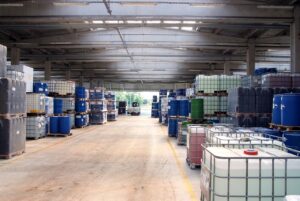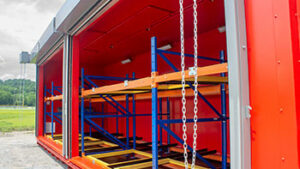Do you know that flammable chemicals, particularly liquids, cause more than 8,000 industrial fires annually? While negligence or some procedural oversight is almost always to blame, most afflicted facilities also failed to invest in guaranteed storage protection. Usually, employees were storing dangerous flammable liquids in ill-advised areas near other combustible materials. Investing in compliant chemical storage protection eliminates exposure to hostile working environments that fuel fires’ voracious wrath. Understanding the complexities of OSHA flammable storage requirements mitigates the propensity for accidental fires and hefty governmental fines.
What Are OSHA’s Flammable Liquids Classifications?
Below are the four primary OSHA flammable liquids classifications, detailing the innate physical properties and pre-existing conditions that pose the greatest flashover risks.
- Category 1 shall include liquids having flashpoints below 73.4 °F (23 °C) and having a boiling point at or below 95 °F (35 °C).
- Category 2 shall include liquids having flashpoints below 73.4 °F (23 °C) and having a boiling point above 95 °F (35 °C).
- Category 3 shall include liquids having flashpoints at or above 73.4 °F (23 °C) and at or below 140 °F (60 °C). When a Category 3 liquid with a flashpoint at or above 100 °F (37.8 °C) is heated for use to within 30 °F (16.7 °C) of its flashpoint, it shall be handled in accordance with the requirements for a Category 3 liquid with a flashpoint below 100 °F (37.8 °C).
- Category 4 shall include liquids having flashpoints above 140 °F (60 °C) and at or below 199.4 °F (93 °C). When a Category 4 flammable liquid is heated for use to within 30 °F (16.7 °C) of its flashpoint, it shall be handled in accordance with the requirements for a Category 3 liquid with a flashpoint at or above 100 °F (37.8 °C). Source: OSHA.gov.
How Many Gallons Flammable Liquids Can I Store?

OSHA says no more than 25 gallons of flammable or combustible liquids may be stored in a room outside of an approved storage cabinet. Additionally, OSHA requires no more than 60 gallons of flammable liquid (flashpoint below 140 degrees F) or 120 gallons of combustible (flashpoint at or above 140 degrees F) can be stored in a single chemical storage container or warehouse. OSHA also requires rated storage safety cabinets when possible. Furthermore, any Category I, II, or III flammable liquids should be kept in closed containers when not in use. NFPA 30 warns against storing more than 120 gallons of Class IB, Class IC, Class II, or Class III liquids in containers. Finally, the NFPA caps any combination of Class IB, IC, or IIIA liquids in metal tanks or metal IBC containers – each not exceeding 793 gallons – at 1,585 total liquid gallons.
Flammable Solids Classification

In addition to defining the scope of flammable liquids, OSHA also addresses flammable solids, including powdered, granular or pasty chemicals. A flammable solid is any solid that is readily combustible or can cause or contribute to a fire through friction. OSHA uses each chemical’s burning rate for flammable solid classification. Powdered metals or metal alloys are considered flammable solids if they “can be ignited and the reaction spreads over the whole length of the sample in 10 min or less,” according to osha.gov.
Criteria for Flammable Solids
- Burning rate test:
Chemicals other than metal powders:
(a) Wetted zone does not stop fire; and
(b) Burning time <45 s or burning rate >2.2 mm/s
Metal powders: Burning time ≤5 min - Burning rate test:
Chemicals other than metal powders:
(a) Wetted zone stops the fire for at least 4 min; and>
(b) Burning time <45 s or burning rate >2.2 mm/s
Metal powders: Burning time >5 min and ≤10 min
Flammable Gasses
Flammable gases also fall under OSHA’s purview and hazardous material classifications. Common examples of flammable gases include methane, butane, hydrogen, propane, ammonia, and acetone. Moreover, aerosol gases are not considered to be flammable gases.
Flammable Gasses Criteria
- Gases, which at 20°C (68°F) and a standard pressure of 101.3 kPa (14.7 psi):
(a) are ignitable when in a mixture of 13% or less by volume in air; or
(b) have a flammable range with air of at least 12 percentage points regardless of the lower flammable limit.
- Gases, other than those of Category 1, which, at 20°C (68°F) and a standard pressure of 101.3 kPa (14.7 psi), have a flammable range while mixed in air.
What is Considered Compliant OSHA Flammable Storage?
Compliant OSHA flammable storage ranges from small safety cabinets to larger storage lockers resembling a Conex trailer. OSHA flammable chemicals storage cabinets and lockers must be designed to limit “the internal temperature to not more than 325 °F when subjected to a 10-minute fire test using the standard time-temperature curve as set forth in Standard Methods of Fire Tests of Building Construction and Materials, NFPA 251-1969.” OSHA has also developed material requirements for metal storage lockers and cabinets. Moreover, OSHA requires the “bottom, top, door, and sides of the (storage) cabinet shall be at least No. 18 gauge sheet steel and shall be double-walled.” Joints of metal storage lockers and cabinets must be riveted, welded, or made tight by equally effective means. Moreover, the storage locker door shall be provided with a three-point lock, and the door sill shall be raised at least 2 inches above the bottom of the cabinet, according to OSHA standard 1910.106(d)(3)(ii)(a).
Can I Stack Flammable Materials?
OSHA also warns against stacking containers with capacities over 30 gallons atop one another. Furthermore, “areas in which flammable liquids are transferred from one tank or container to another container shall be separated from other operations in the building by adequate distance or by construction having adequate fire resistance,” according to OSHA. OSHA Regulation 1910.106(d)(5)(vi)(f) also requires aisles or passable egresses “of at least 3 feet wide shall be provided where necessary for reasons of access to doors, windows or standpipe connections.”
Lasting, Compliant Chemical Protection

Our fire-rated chemical storage lockers meet all stringent OSHA and NFPA 30 flammable storage requirements. Optional mechanical ventilation prevents the volatile accumulation of toxic vapors that cause flashover events. Furthermore, we can equip larger chemical payloads with superior fire suppression protection. The optional fire suppression uses an overhead piping system to douse flames with a dry-chemical agent instantaneously. Wide-swinging or roll-up doors also allows for the easy storage and removal or steel barrels and IBC tote containers with a forklift or hand-truck. Contact us today for a free quote and consultation.


